Newark Star-Ledger critic Stephen J. Whitty, writing in an e-mail, feels that Phil Villarreal‘s 10,000 B.C. revew “is funny but too kind. A lot of the photography, especially in low-light situations, is rough and grainy.” He also feels that Villarreal’s take is “kind of blind to just how offensive the movie is.” In a culturally reflective, racial-commentary sense, he means.
“I mean, a bunch of nice pretty Northern folks (who speak English) lead a coalition of the willing (include several African tribes, who didn’t know what to do until a white guy show up) against a lot of evil hook-nosed Southern folks who speak some strange language, wrap rags around their heads, prostate themselves in prayer and build pyramids in the desert?
“There’s always a lot of us-vs-them xenophobia at work in these epics (much as the 300 crowd hated to see it) but I thought Emmerich, who has kind of a reactionary streak to begin with, was a little too obvious this time around. Think you should see this one for yourself.”
Whitty’s full review (no URL yet, but here’s the page) will be up Friday. I guess I’ll be paying to see this sucker sometime on Friday night.
Weekend Numbers
Roland Emmerich‘s 10,000 B.C. (opening Friday) is tracking at 84, 42 and 27….very heavily male (particularly younger male), rated PG-13, has to do at least $30 million. No one trusts tracking after after last weekend’s Semi-Pro debacle, but trust me — a 27 first choice means that that all the young animals will be out in force.
Roger Donaldson‘s The Bank Job (also this weekend) is running at 42, 32 and 8. A general awareness rating of 42 is extremely weak for a film opening in two days (Owen Wilson‘s Drillbit Taylor isn’t out until 3.21 but has a general awareness level of 45). Lionsgate is probably confining its run to 50 major urban markets and therefore not reaching every Tom, Dick and Harry.
The presumably contemptible College Road Trip is, of course, looking fairly good with an 83, 24 and 4. Family audience, bring the tots, spillled drinks and popcorn on the floor..
Doomsday (opening 3.14) is running at 47, 24 and 2. Dr. Seuss’ Horton Hears a Who (also 3.14) is at 77, 40 and 9. Never Back Down (same weekend) is tabulating 32, 34 and 3. As mentioned, Drillbit Taylor (3.21) is 45, 26 and 2. Shutter (also 3.21) is at 30, 22 and 1. Tyler Perry’s Meet the Browns is running at 47, 25 and 5 — a low figure for a Perry film at this stage (i.e., two weeks out).
21 (opening 3.28) is at 39, 34 and 4. Run, Fat Boy, Run (ditto) is at 35, 15 and 1. Kimberly Peirce’s Stop-Loss (3.28) is at 26, 20 and 1. And Superhero Movie (same) is at 37, 20 and 1.
Villarreal vs. “10,000 B.C.”
“Watch 10,000 B.C. with the right mindset and you can appreciate it as a fairly effective comedy,” writes Arizona Daily Star film critic Phil Villarreal. “As funny as Juno, even. [And] the picture quality is excellent. Beautiful, even. The only problem is whenever it talks, you get really annoyed and want to cover your ears and scream for it to stop. But overall the movie isn’t that bad for a bunch of cavemen, who were much stupider than all of us living today.

“The one way 10,000 B.C. and Juno differ is a small story point. Instead of focusing on a wise-cracking teenager who’s looking for someone to adopt her baby, 10,000 B.C. is about a caveman (Steven Strait) who’s cavewoman (Camilla Belle) is kidnapped (i.e., adopted) by a traveling group of supercavemen who are looking for slaves to build their pyramids.
“The picture quality is excellent, though. Beautiful, even. The only problem is whenever it talks, you get really annoyed and want to cover your ears and scream for it to stop. Just like Nanny from that TV series The Nanny. But overall the movie isn’t that bad for a bunch of cavemen, who were much stupider than all of us living today.
“I can’t figure out exactly Roland Emmerich’s film is set, but it’s definitely ancient times. Like before they had cars, guns or tabloid blogs. And definitely before they had cohesive plots or dialogue that made sense.
“But at least there were sabertooth tigers, mastadons and togas, and at least most of the people knew how to speak English, even if they did so with medieval British accents. The tribes which were too dumb to have invented English yet speak their own crazy gibberish languages, but at least the filmmakers translated it with subtitles, so we could learn ‘Agllabogatttarangaba!’ means ‘Oh, no! I’m being impaled by a sabertooth tiger’s saberteeth!’ Which is really helpful.
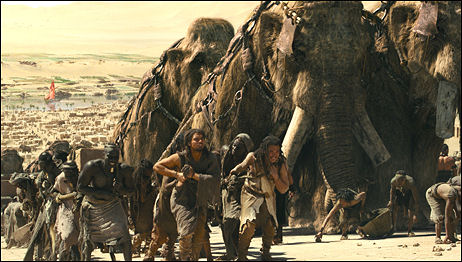
” Emmerich surely must have cheated in making his special effects by using actual footage from whatever time it was the movie was set. I’m onto you, Roland. No way your fancy computers and puppets can make mastadons look so real.
“The beasts look more true-to-life than the people, in fact. And are mostly better actors. And have more interesting things to say. But oh well. Complaining about stupidity in an action movie is like whining about wild cherry flavoring in Wild Cherry Pepsi. You just accept it and roll with it, and even try to appreciate it a little.
“The one thing those supercavemen weren’t counting on was that three people from a tribe they just marauded would track them down and topple their entire empire. If you look it up, I think you’ll discover similar oversights were made by the Roman Empire and the Giuliani campaign.
“The funniest part of the movie involves a witch doctor lady who sits in Dahlsim’s Yoga Flame pose and channels the emotions, sights and sounds of the heroes’ journey, flipping out whenever they encounter an enemy or recite painful dialogue.
“Why she does this I’ll never know. Maybe because this was before the days of DVD back then and all they had was VHS, which were such a hassle because they’d wear out too easily and if you didn’t rewind the tapes before you brought them back to Blockbuster you’d get charged an extra dollar. Plus the picture quality sucked.”
Indians at the gate
Tina Fey bad, Tom Hanks good. Except for his line about being bored by the election and that he wishes it was over. So do a lot of other people, but did Henry Fonda and Ward Bond talk about how bored they were when the Indians were climbing over the walls of the fort in Drums Along the Mohawk?
Baby Mama vs. Hillary shilling
The Reeler’s Stu VanAirsdale reported this morning that the Tina Fey/Amy Poehler comedy Baby Mama (Universal, 4.25) will open the Tribeca Film Festival on 4.23. It’s about the blue-collar Poehler becoming the surrogate mother of the affluent Fey’s child…whatever. Maybe it’ll rock, and maybe it’ll be a feast of “heh-heh” humor.
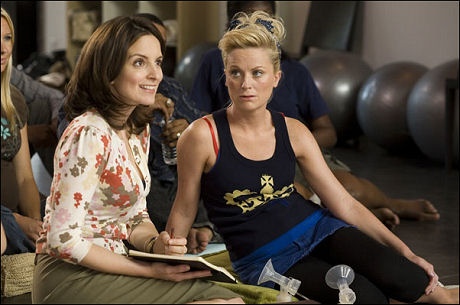
Tina Fey, Amy Poehler
I need to be upfront and confess that unfair as this may sound, a certain part of me would like to see Baby Mama go down as a kind of karma payback for Fey’s Hillary shilling. It’s a small-time thing to say, I admit, but I do feel this way. Fairly strongly, truth be told. But if it’s good I’ll say that and I won’t let this other stuff in.
If nothing else the primary season has been an education about what it feels like to be caught up a tribal feud, and in the grip of excessive hatred that probably isn’t good for my soul or my health. As the Palestinians feel about the Israelis, as the Bosnian Muslins feel or felt about the Serbs, as the Sunnis and the Kurds feel about the Shiites and vice versa, I feel I now understand.
Breakfast at Tomy’s
My transmission collapsed early this morning, so I had the car towed all the way to Santa Monica Motors. Two days from now I’ll be $1050.00 poorer and back on the road. I’ve been filing all morning from a Starbucks at Olympic and Sawtelle, which is one long block up from Tomy’s on Pico, where I had breakfast this morning. Off to Best Buy soon to get a scanner so I can digitize ’90s articles for “Yellowing with Antiquity.”
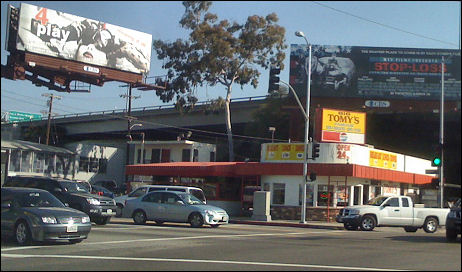
Denby on “Bank Job”
“Given the nature of the material, which comes to a climax with half of London’s criminal and Secret Service personnel chasing the baffled thieves, you would expect The Bank Job to be played as farce, or perhaps as a satire on the manners of the upper class,” writes New Yorker critic David Denby. “That’s the way Richard Lester or the Boulting brothers would once have told such a story.

“But Roger Donaldson, the Australian-born director who, in recent years, has become the kind of solid pro that Hollywood developed in the nineteen-thirties and forties, has made a straightforward, tight-knit crime thriller, which incidentally features some very odd plot elements.
“Respecting the rules of the game, Donaldson assembles the robbery team (guys who work at a car dealership and other minor jobs) and gives us a brief account of their everyday lives; he lays out their loyalties to one another and to the upwardly bound model, with whom two of them had affairs many years earlier. The plot, which includes such intriguing minor characters as the porn king of Soho (played suavely by David Suchet, of Poirot fame), is terrifically complicated, so Donaldson moves things along briskly and refuses to dwell on violence (as an American movie would).
“The director has done his best to restore the civilized pleasures of the genre. There are a couple of mild movie jokes: the filmmakers cast the tall, darkly handsome Richard Lintern, who looks as if he had just missed out replacing Sean Connery as James Bond, as the chief MI5 agent. And Donaldson has got a star in the making: Jason Statham, as Terry Leather, the head of the robbery gang. Statham, who has been playing tough-guy roles with authority in the Transporter films, has clipped hair, burning eyes, and a voice that sounds like acid running over gravel.”
Wait a minute…
I’ve been shown data indicating that in terms of delegates chosen at last night’s caucuses, Hillary Clinton may not have won Texas. Maybe. The final counts aren’t in. But what I’m looking at seems persuasive.
With an official Texas website tally of delegates that began to be counted last night in the caucuses, otherwise known as Texas Democratic Party Precinct Conventions, Hollywood Elsewhere columnist Moises Chiullan, who paticipated in a caucus last night in Austin, is telling me that if trends continue Barack Obama is going to emerge as the overall Texas delegate winner.
Look at the 31 Senate districts in this chart. By my count, Clinton is ahead in 11 of these districts (#19 through #22, #26 through #31) and Obama is ahead in the other 20.
The primary voting resulted in Clinton with 64 delegates and Obama with 62 delegates. The caucuses are choosing another 68 delegates, and if the trends evident in last night’s caucus voting are ratified by the still-continuing manual counts, it looks as if Obama will end up with somewhere around two-thirds of the 68, or roughly 45 or 46 delegates to Clinton’s 22 or 23. If the numbers continue along the lines of what’s already tallied, I’m saying.
In short, it may well be that Clinton didn’t take Texas after all. Maybe.
The people who were elected to be Texas delegates have to show up at the various Texas county conventions on March 29th. So it’s vitally important for every last Obama delegate to show up — no colds or fevers, no I-couldn’t-get-a-babysitter, nothing like that.
Donaldson in Burbank
[Update: This story was accidentally deleted during an iPhone edit yesterday afternoon. I re-posted it around 6 pm last night but all the reader comments were lost.] I drove out last night to the TV Academy theatre on Lankershim (which is way out there, about halfway to Palmdale) for a chat with The Bank Job director Roger Donaldson. He was waiting for a screening of his well-reviewed British crime film to finish so he could do a stage chat with moderator Pete Hammond.
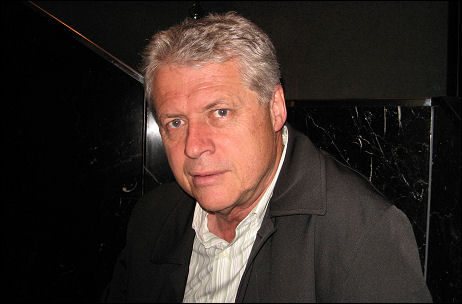
Roger Donaldson — Tuesday, 3.4, 8:35 pm
The Bank Job isn’t a whammy-chart action film. No car chases, no explosions and star Jason Statham only beats up one guy in the whole thing. And it’s not a classic drama. But it’s the best crafted and most gripping low-key suspense thriller I’ve seen in ages. “I don’t want to blow a gasket over this thing because it’s just a good British popcorn film,” I wrote last Friday, “but entertainments of this sort — tight, tough, well-honed — are few and far between.”
I asked Donaldson if the fact that guys like myself are fans of The Bank Job is a bad box-office omen. Serious action and thriller fans tend to like their movies to be a little dumber and blunter…no? I shouldn’t say this, I suppose. I just feel that serious action hits are — I want to put this carefully — not exactly aimed at a cretin mentality, but they have to at least make room for it. Is that fair?
I told Donaldson I was especially pleased with The Bank Job‘s expositional dialogue, which always kept me engaged and feeling informed and never made me feel like I was falling behind. Casting was a very important element, he said, with 30-plus speaking parts. He shot The Bank Job in about 60 days.
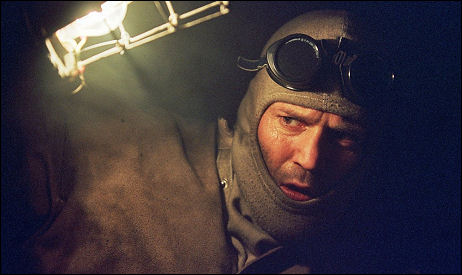
Jason Statham in The Bank Job
I haven’t gone to Statham’s previous films because it doesn’t thrill me that much to see the hero kick the shit out of the bad guys, I told him. But when Staham goes to town on a guy (or two or three) in The Bank Job, I loved it. Statham could be the new Steve McQueen, we agreed, but in the future he has to try and get himself into more action movies that Matt Damon might say yes to, and fewer that Jean Claude Van Damme might star in.
What is Donaldson’s favorite heist film? “I haven’t seen a lot of them,” he confessed. He’s never even seen the popular Topkapi, he said. But he’s a big admirer of Jules Dassin‘s Rififi. He believes, however, that the music-free heist sequence wouldn’t, in a new version, work with today’s audience unless it was scored, and he’s not sure that the dark ending (the wounded Tony driving the little kid back into Paris and the arms of his mother before dying) would work either.
Hammond said to me later that Donaldson is a dead ringer for Bill Clinton. I don’t disagree, but the more I think about it the less I agree. He looks like Clinton’s older, more bohemian older brother from California.
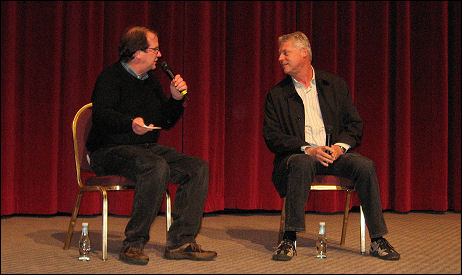
Pete Hammond, Donaldson — Tuesday, 3.5, 9:05 pm
No More Mr. Nice Guy
All Barack Obama supporters feel badly this morning about New Hampshire redux. The distinguished and vetted Hillary Clinton threw the sink, the plumbing and whatever globs of fecal matter she was able to scoop out, and enough of it stuck to the wall or pushed buttons or whatever. And now the concern is that come April 22nd the fearful, insufficiently educated lunchbox proles in Pennsylvania (along with that state’s insufficiently educated white women over 50) will probably give her another win.
Even though Obama’s delegate lead is truly insurmountable, and despite the almost certain fact that things will go his way again in Missisippi and Wyoming and beyond. Anyone who knows the game and how to count will tell you the math and the likely super-delegate tipping factor over the next few weeks makes a Barack victory a near-certainty. But this morning the wind and the ugliness is with Hillary, and that’s a fact. It’s also a fact that the Republicans are tickled, delighted….rolling around on the ground.
It’s time now for Team Obama to get up, dust themselves off and unsheath the swords. It’s not just the voters who want to know about Barack’s three-in-the-morning courage — I want to see this! The name of the game from here on should be “No More Mr. Nice Guy.” People everywhere understand that alpha uplift will only get you so far. As that priest in the Woody Allen joke tells the mother, “I’ll pray for your son, sure, but if he can punch it’ll help.”
If you need to watch Gone With the Wind again to get your head straight, do so. Too many people out there seem to believe that Barack Obama has too much Ashley Wilkes and Melanie Hamilton in him and not enough Rhett Butler or Scarlett O’Hara. Barack needs to do that radish-in-the-fields moment. He needs to stand up, clench his fist and say to the heavens, “I’ll never be taken down by that bitch and her henchmen again! ”
Musto/Lohan/Monroe
“I’ve long lived quite dangerously myself, and so, anxious to share my desperate man-tits with an audience beyond Chelsea, I gleefully agreed to star in an homage to an homage: Musto as Lohan as Marilyn. That’s three generations of loveliness, and I prepared for it by not shaving or waxing a thing, just letting it all hang in the wind as both a nod to history and a means of reclaiming control.

Just like with Marilyn and Lindsay, people have always grabbed at me, wanting a piece of my piece and a slice of my soul, but usually with more pepperoni and less cheese. Well, this time, I was seizing the power back by saying: “My bits are only mine to give. Now here they are, world. Take it all!” — Village Voice columnist Michael Musto in a piece/photo spread that went up today. The first and final observation is that Lindsay Lohan‘s Marilyn photos were hotter, yes, but only somewhat.
Cheers and salutations to Musto for a brilliant parody/media move.
Forget “Paranoid Park”
“Forget Gus Van Sant‘s Paranoid Park, an unfocused, meandering and even dreary look at how a Portland skateboarding teenager (Gabe Nevins) doesn’t deal with his complicity in an impulsive accidental homicide. It’s another atmospheric exotic-youth-culture piece with a minimalist plot, but nowhere near as striking or stylistically distinguished as Van Sant’s Elephant and Last Days.
“I’m calling it his first not-very-good film since Gerry. I’m sorry to say this given the respect I have for Gus, but you can’t hit it out of the park every time.” — written from the Cannes Film Festival on 5.22.07. IFC is opening Paranoid Park on Friday, 3.7.

